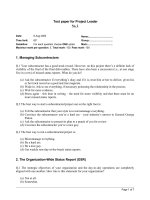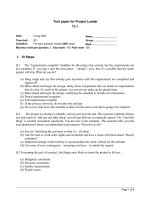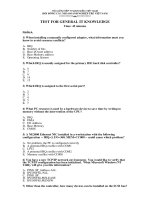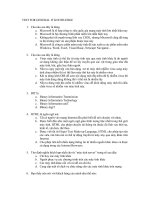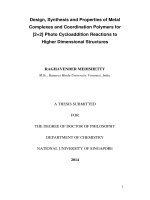metal for paedo
Bạn đang xem bản rút gọn của tài liệu. Xem và tải ngay bản đầy đủ của tài liệu tại đây (472.56 KB, 74 trang )
Outline
What is a metal ?
General properties
Structure and bonding
Phases and phase transformations
Structure – property relationships
Chemical properties
H He
Li Be B C N O F Ne
Na Mg Al Si P S Cl Ar
K Ca Sc Ti V Cr Mn Fe Co Ni Cu Zn Ga Ge As Se Br Kr
Rb Sr Y Zr Nb Mo Tc Ru Rh Pd Ag Cd In Sn Sb Te I Xe
Cs Ba Lu Hf Ta W Re Os Ir Pt Au Hg Tl Pb Bi Po At Rn
Fr Ra Lr Rf Db Sg Bh Hs Mt Uuu Uub Uub
What is a Metal ?
Non-metals
Metals
La Ce Pr Nd Pm Sm Eu Gd Tb Dy Ho Er Tm Yb
Ac Th Pa U Np Pu Am Cm Bk Cf Es Fm Md No
Opaque
Lustrous
High melting point
Good conductors of heat
Good conductors of electricity
Dense
Strong
Malleable
Ductile
Properties of Metals
Bonding
e
-
e
-
e
-
e
-
e
-
e
-
e
-
e
-
e
-
e
-
e
-
e
-
e
-
e
-
e
-
e
-
e
-
e
-
e
-
e
-
e
-
e
-
e
-
e
-
e
-
e
-
e
-
Metallic Bonding
Other Types of Bonding
Covalent Bonding
e.g. salt
e
-
e
-
CC
Ionic Bonding
e.g. polymers
Na
+
Cl
-
Ionic bonding is often stronger than metallic bonding
Ceramics tend to have higher melting points than metals
Covalent bonds can also be extremely strong
Covalently bonded materials may also have higher melting
points than metals, e.g. diamond
However, many covalently bonded materials have very low
melting points due to the existence of molecules
Inter-molecular bonds can be rather weak (e.g.
thermoplastic polymers)
Melting Points
Electrical Conductivity
Freely moving electrons can conduct electricity
Metallic materials tend to be good electrical conductors
Some metals are better conductors of electricity than
others, e.g. copper is a better electrical conductor than
tin
Ceramics and polymers tend to be good electrical
insulators
Crystallinity
In a crystalline solid, the “lattice” is made up of repeating
units of atoms
A repeating array of atoms in a lattice is called the “unit cell”
The smallest repeating array of atoms is called the
“primitive” unit cell
The lengths of the sides of the unit cell are called the lattice
parameters
Packing of Atoms
A B A B A B
Hexagonal close-packed (hcp)
Each unit cell here contains 2 atoms
8 x 1/8 at each corner
1 x 1 in the centre
Titanium (Ti) - hcp
A B C A B C A B C
Face centred cubic (fcc)
8 atoms at corners of the unit cell
1 atom centered on each of the faces
The atom on the face is shared with
the adjacent cell
In total, the unit cell contains 4
atoms: 8 x 1/8 at each corner
6 x 1/2 at each face
Gold (Au) - fcc
Body centred cubic (bcc)
A third common packing arrangement in metals is body centred cubic
The BCC unit cell has atoms at each
of the eight corners of a cube plus one
atom in the center of the cube
The unit cell contains a total of 2
atoms
1 x 1 in the centre
8 x 1/8 at the corners
Iron (Fe), Vanadium (V), Chromium (Cr) - bcc
Aluminum FCC Nickel FCC
Cadmium HCP Niobium BCC
Chromium BCC Platinum FCC
Cobalt HCP Silver FCC
Copper FCC Titanium HCP
Gold FCC Vanadium BCC
Iron BCC Zinc HCP
Lead FCC Zirconium HCP
Magnesium HCP
Crystal structures of some metals (rt)
The crystal structure of a metal can determine some of its
mechanical properties
E.g. ductility
The most familiar phases are solid, liquid and gas
Within the solid-state, a metal may exist in several different
solid phases
Pure iron has three different solid phases (α, γ and δ-Fe) at
different temperatures
Each of these phases has its own distinctive structure and
properties, although all three are made up of iron atoms
α-Fe has the bcc structure
γ-Fe has the fcc structure
Phases
Phase Transformations
As iron is heated from room-temperature to above its
melting point, the following changes in phase occur:
•
α transforms to γ;
•
γ transforms to δ;
•
δ transforms to liquid iron
These changes are examples of phase transformations
Phase Equilibria and Phase Diagrams
Stable
Metastable
Unstable
A phase diagram is a chart which shows which
phases are stable under which conditions
For a single element material, the variables that influence phase stability
are temperature and pressure
Extremely high pressures are generally required to significantly change
phase equilibria for solid metals
Under normal conditions, the phase diagram for a pure metal generally
needs only a temperature axis
The pure iron phase diagram at
constant pressure (not to scale)
The phase diagram consists of single phase regions
Two phases are only found together at a point
Phase Diagrams
T
Liquid
δ-Fe
γ-Fe
α-Fe
Single crystal: lattice extends the edges of the material, e.g.
a diamond
Metal single crystals are possible: e.g. Ni alloy turbine
blades used in aero gas-turbine engines (“jet engines”) can
be produced as single crystals
Above their melting points, metals are liquids. The atoms are
randomly arranged and relatively free to move
On cooling to below the melting point, the atoms rearrange
forming the ordered, crystalline solid structure
Single Crystal Metals
Polycrystalline Metals
In most cases, solidification begins from multiple sites,
each of which can produce a different orientation
The result is a “polycrystalline” material consisting of
many small crystals of “grains”
Each grain has the same crystal lattice, but the lattices
are misoriented from grain to grain
The “microstructure” of a material is the portion of the
material’s structure that can be observed under a microscope
A good quality light microscope will produce a magnification of
around 1,000 x
A modern electron microscope is capable of magnifications of
1,500,000 x or more
Microstructure features are in the range
~100 pm (i.e. 1 x 10
-10
m, 0.1 nm, or 1 Å)
to ~100 µm (i.e. 1 x 10
-4
m, or 0.1 mm)
Feature such as grains count as microstructure
Both microstructure and crystallography influence the
properties of a metal
Microstructure
In 3D, the grains in a polycrystal are usually polygonal
The interfaces between the grains (“grain boundaries”) have
an interfacial energy associated with them
Matter always tries to adopt the lowest energy condition
possible
The interfacial energy of the sample can be reduced by
minimising the total interfacial area present
Spherical grains would give the lowest surface area to
volume ratio, but it is impossible to completely fill space by
packing spheres together
The surface area to volume ratio of polygons is nearly as low
as that of spheres, but polygons can stack together to fill the
space completely
Grain Shapes
If a molten metal is cooled very rapidly, the atoms do not have
time to rearrange to form an orderly crystalline lattice
Instead, a random “amorphous” arrangement is produced and
the result is a non-crystalline material
The best known amorphous material is window glass:
amorphous materials are often referred to as glasses
Metals can usually crystallise even at very high cooling rates,
but under extreme conditions metallic glasses can be
produced in some alloys
NB metallic glasses are not transparent
The lack of long range order in metallic glasses produces
unusual properties which may have specialist applications
Amorphous Metals
